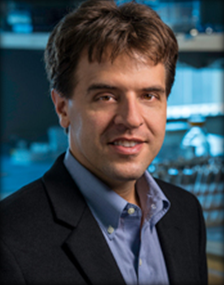 Karl Deisseroth, MD, PhD, will present “Optical Deconstruction of Fully-Assembled Biological Systems” as the 15th annual Fredric S. Fay Memorial Lecture. Dr. Deisseroth (at right) is a Howard Hughes Medical Institute Early Career Investigator and the D.H. Chen Professor of Bioengineering and of Psychiatry and Behavioral Sciences at Stanford University.
Karl Deisseroth, MD, PhD, will present “Optical Deconstruction of Fully-Assembled Biological Systems” as the 15th annual Fredric S. Fay Memorial Lecture. Dr. Deisseroth (at right) is a Howard Hughes Medical Institute Early Career Investigator and the D.H. Chen Professor of Bioengineering and of Psychiatry and Behavioral Sciences at Stanford University.
The Fred Fay lecture is given in remembrance of the late UMass Medical School professor of physiology and his scientific contributions, particularly to the field of biomedical imaging. This year’s lecture is scheduled for Nov. 18 at 3 p.m. in the Albert Sherman Center auditorium. A reception in the ASC Cube (AS3.2119 and AS3.2120) will immediately follow the lecture.
Dr. Deisseroth pioneered the use of optogenetics for understanding complex brain processes. Optogenetics is regarded by many in the field as the most important technological development in brain science in the last 40 years. Deisseroth and his collaborators developed methods utilizing optogenetic tools that result in targeted expression of light-activated ion channels in specific groups of mammalian neurons. Brief pulses of light open the channels allowing precise manipulation of neural activity. The method has revolutionized the way scientists attempt to answer questions about cognitive brain functioning and behavior and develop treatments for debilitating neurodegenerative and neuropsychiatric brain diseases.
Within the past year the Deisseroth lab has introduced another revolutionary new method, called Clarity, where cloudy membrane lipids are replaced with clear water-soluble acrylamide. The resulting transparent whole mouse brain allows clear three dimensional visualization of neurons, labeled for particular proteins or neurotransmitters. Clarity eliminates the need for tissue sectioning and digital stitching together of sections that can introduce error into brain images. Instead, Clarity yields unprecedented three dimensional details of the structural organization of whole mouse brain and of similar sized blocks of human postmortem tissue. Clarity can render any type of tissue transparent and thus has the potential for far reaching research applications.
Deisseroth is a member of the Institute of Medicine and the National Academy of Sciences and has received numerous honors, including a Society for Neuroscience Young Investigator Award, the Nakasone Prize from the International Human Frontier Science Program/HFSP, the Zuelch Prize from the Max Planck Society, the Richard Lounsbery Prize from the National Academy of Sciences, and the Brain Prize from the Grete Lundbeck European Brain Research Foundation.
For additional information, contact lecture host Ann R. Rittenhouse, PhD, associate professor of microbiology & physiological systems, at 508-856-3735.